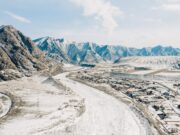Introduction to Siberia
Geographic Overview and Significance
Siberia, a vast and enigmatic region in northern Asia, occupies a significant portion of Russia, spanning approximately 13.1 million square kilometers. This vast expanse, known for its dramatic landscapes and extreme climates, stretches from the Ural Mountains in the west to the Pacific Ocean in the east. It is home to an astonishing variety of ecosystems, from dense taiga forests to expansive tundra and towering mountain ranges.
A Brief History of Exploration
Historically, Siberia has been a land of mystery and exploration. Early Russian expeditions in the 16th century paved the way for the region’s gradual incorporation into the Russian Empire. These journeys revealed Siberia’s immense natural resources, including minerals, timber, and fur, which played a crucial role in shaping Russia’s economy and global standing.
The Importance of Natural Landscapes and Ecosystems
Siberia’s natural landscapes are among its most remarkable features. It houses Lake Baikal, the world’s deepest freshwater lake, and vast forests that act as a critical carbon sink. The region’s biodiversity includes unique flora and fauna, such as the elusive Siberian tiger. Siberia is not only a testament to the beauty and power of nature but also a vital part of Earth’s ecological balance, making its preservation essential for future generations.
Iconic Natural Landmarks
Lake Baikal: The World’s Deepest Freshwater Lake
Lake Baikal, often called the “Pearl of Siberia,” holds the title of the world’s deepest freshwater lake, plunging to depths of over 1,600 meters. This ancient lake, estimated to be over 25 million years old, is home to a unique ecosystem, including hundreds of species found nowhere else on Earth, such as the Baikal seal. Its crystal-clear waters and surrounding landscapes attract visitors and researchers alike.
Altai Mountains: A UNESCO World Heritage Site
The Altai Mountains, a breathtaking range in southern Siberia, are celebrated for their pristine beauty and cultural significance. Designated as a UNESCO World Heritage Site, this region boasts snow-capped peaks, serene valleys, and an incredible variety of plant and animal life. The Altai is also an important cultural hub, with ancient petroglyphs and nomadic traditions adding to its charm.
Lena Pillars: Geological Marvels
The Lena Pillars, towering stone formations along the Lena River, stand as one of Siberia’s most striking natural wonders. These vertical cliffs, shaped over millennia by weather and erosion, hold both geological and cultural importance, symbolizing Siberia’s rich natural history.
Tundra and Taiga Biomes: Expansive Ecosystems
Siberia’s tundra and taiga landscapes showcase the diversity of its ecosystems. The tundra features vast, treeless plains home to hardy flora and fauna, while the taiga, the largest forest biome in the world, is a critical carbon sink, hosting diverse wildlife like bears, wolves, and reindeer.
Unique Wildlife of Siberia
Overview of Siberian Fauna
Siberia is home to a remarkable variety of wildlife, adapted to its harsh and diverse environments. The iconic Siberian tiger, one of the largest and most powerful big cats, roams the dense forests of the region. Brown bears, known for their strength and adaptability, are commonly found in Siberia’s taiga. Snow leopards, elusive and majestic, inhabit the rugged mountains, blending seamlessly into the rocky terrain. These species symbolize Siberia’s untamed wilderness and its ecological importance.
Birds of Siberia
Siberia’s vast landscapes serve as vital habitats for numerous bird species, including rare and migratory ones. The Siberian crane, a critically endangered bird, travels thousands of kilometers to breed in Siberia’s wetlands. Other notable avian species include owls, hawks, and woodpeckers, all of which thrive in the region’s diverse ecosystems. Migratory birds use Siberia as a crucial stopover during their seasonal journeys.
Endemic Species and Conservation Efforts
Siberia’s isolation has given rise to several endemic species, found nowhere else in the world. Efforts are underway to protect these unique animals, focusing on habitat preservation, anti-poaching measures, and breeding programs. Conservation initiatives are vital to ensuring that Siberia’s extraordinary wildlife continues to thrive for generations to come.
Challenges and Opportunities
Impact of Climate Change on Siberia’s Environment
Siberia is significantly affected by climate change, with rising temperatures leading to permafrost thaw. This thaw releases greenhouse gases like methane, contributing to global warming and threatening the delicate balance of ecosystems. Wildlife species, such as reindeer and Siberian tigers, face habitat disruptions as their environments undergo rapid changes. Melting ice and altered river flows also affect aquatic ecosystems, including the unique biodiversity of Lake Baikal.
Threats from Deforestation and Human Activity
Human activity poses another critical challenge to Siberia’s natural landscape. Logging and deforestation have reduced vast expanses of taiga forests, which serve as vital carbon sinks. Additionally, industrial development and mining activities disrupt habitats and pollute the environment. Poaching remains a significant threat to endangered species like the snow leopard and Siberian tiger, further endangering their survival.
Ecotourism and Sustainable Practices
Despite these challenges, Siberia holds immense potential for ecotourism, which can raise awareness about its natural beauty while promoting conservation. Responsible tourism practices, such as guided wildlife tours and eco-friendly accommodations, can generate funds for preservation efforts. Sustainable development initiatives, coupled with stricter regulations, can help balance human activity with the need to protect Siberia’s unique environment and wildlife.

















































